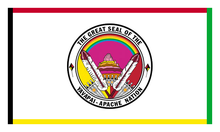Yavapai–Apache Nation




The Yavapai–Apache Nation (Yavapai language: Wipuhk’a’bah and Western Apache language: Dil’zhe’e[1]) is a federally recognized Native American tribe in the Verde Valley of Arizona. Tribal members share two culturally distinct backgrounds and speak two indigenous languages, the Yavapai language and the Western Apache language. The Yavapai–Apache Nation Indian Reservation, at 34°37′10″N 111°53′46″W / 34.61944°N 111.89611°W, consists of five non-contiguous parcels of land located in three separate communities in eastern Yavapai County. The two largest sections, 576 acres (233 ha) together – almost 90 percent of the reservation's territory, are in the town of Camp Verde (Yavapai: ʼMatthi:wa; Western Apache: Gambúdih[2]). Smaller sections are located in the town of Clarkdale 60.17 acres (24.35 ha), and the unincorporated community of Lake Montezuma (5.8 acres (2.3 ha)). The reservation's total land area is 642 acres (260 ha). The total resident population of the reservation was 743 persons as of the 2000 census. The 2010 Census reported 1,615 people on the reservation. Of these, 512 lived in Camp Verde, 218 in Clarkdale, and only 13 in Lake Montezuma.
History[edit]
The Yavapai–Apache have lived in the southwest since 1100 C.E. Their use of the land helped them to survive as hunters and gatherers. Chief YumaFrank, Chief Viola Jimulla, and Carlos Montezuma were some of the first leaders of this nation. Beginning in 1865 the Yavapai were moved to several reservations such as: Colorado River Reservation, Fort McDowell, RioVerde, San Carlos, Camp Verde, Middle Verde, Clarkdale, and Prescott.[3][page needed]
Government[edit]
The Yavapai–Apache government has three branches: Executive, Legislative, and Judiciary. The Executive branch is comprised of the Chairperson, Vice Chairperson, Council Secretary, and Council Treasurer, who oversees the administration of tribal business. The Legislative branch is the Tribal Council, which has nine members, including the Chairperson and the Vice Chairperson. The Council's powers include developing laws, codes, and ordinances and representing the Yavapai-Apache people in all matters concerning their health and welfare. The tribal membership elects the Council, which consists of the Chairperson, Vice Chairperson, and seven other Tribal Council members. The Judicial Branch consists of a Trible Court, a Court of Appeals, and other lower courts considered necessary by the Tribal Council. The judiciary interprets and applies the laws of the Nation and resolves legal matters.[4][5][6]
In 2024, Tanya Lewis serves as the Chairwoman and Ricardo Pacheco is the Vice Chairman.[4]
Communities[edit]
- Camp Verde (Yavapai: ʼMatthi:wa; Western Apache: Gambúdih[7])
- Clarkdale (Yavapai: Saupkasuiva[8])
- Lake Montezuma (Rimrock)
Attractions[edit]
The Yavapai–Apache Nation operates the Cliff Castle Casino, a popular gaming, recreation, dining and lodging attraction in the Verde Valley.
Education[edit]
The reservation is served by the Camp Verde Unified School District.
See also[edit]
References[edit]
- ^ Yavapai-Apache Nation
- ^ William J. de Reuse (2006). A Practical Grammar of the San Carlos Apache Language. Lincom Europa.
- ^ Rasmussen, R.E.H American Indian Tribes. Salem Press, 2000. ISBN 978-0893560638.
- ^ a b "Yavapai-Apache Nation of the Camp Verde Indian Reservation | Native American Advancement, Initiatives, and Research". naair.arizona.edu. Retrieved 2024-06-29.
- ^ "Yavapai-Apache Nation: Executive Functions Excerpt | Native Nations Institute's Constitution Resource Center". nniconstitutions.arizona.edu. Retrieved 2024-06-29.
- ^ "Yavapai-Apache Constitution" (PDF). The University of Arizona. Archived from the original (PDF) on January 13, 2024. Retrieved June 29, 2024.
- ^ William J. de Reuse (2006). A Practical Grammar of the San Carlos Apache Language. Lincom Europa.
- ^ E.W. Gifford, Northeastern and Western Yavapai, University of California Publications in American Archaeology and Ethnology. Berkeley: University of California Press, 1936. Page 248, footnote 7. PDF copy, hosted by the Arizona Navigable Stream Adjudication Commission, retrieved 31 August 2017.
- Yavapai–Apache Nation Reservation, Arizona United States Census Bureau
- Rasmussen, R.E.H American Indian Tribes. Salem Press, 2000.
External links[edit]
- Yavapai–Apache Nation, official website
- Yavapai–Apache Nation, Arizona Intertribal Council
- Cliff Castle casino and hotel

